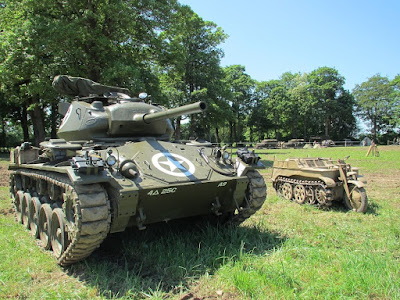
We visited the Normandy American Cemetery in Colleville-sur-Mer, France, where more than 9,300 Americans are laid to rest, and the names of another 1,000+ missing in action are listed. In the largest amphibious assault in world history, the Allies landed more than 34,000 troops on Omaha Beach and 23,000 troops on Utah Beach on 6 June, 1944, along with another 70,000 British and Canadian troops who landed at Juno, Gold and Sword beaches. Omaha Beach was the most heavily fortified of the beaches, and saw the greatest number of casualties. The memorial cemetery is situated on the high ground above Omaha Beach.

While visiting Normandy, we stayed in an historic house in the nearby town of Falaise.

Besides being surrounded by war history, the town is also the birth site of William the Conqueror. Here the boys pose on the front deck, with the castle of William the Conqueror visible on the horizon.

The house overlooks the river Ante, and is the site of the "Falaise Pocket", where more than 60,000 German troops were surrounded by the rapidly advancing Allied forces shortly after D-Day. More than 10,000 Germans were killed here in the fighting, and the remaining 50,000 were taken prisoner.

The castle of William the Conqueror, as seen from the street outside the home where we stayed in Falaise, France.

In preparations for this weeks' 74th anniversary of the D-Day landings, the areas surrounding the beaches held a reenactment of the Allied landings. Here, townsfolk dressed in era clothing and welcomed the Allied soldiers as they liberated France.

An infinity pool, with engraving of beach locations, as you enter the cemetery memorial.

Looking at the invasion map, with the actual location of Omaha Beach just over their shoulders.

For each American who perished in Operation Overlord, the families were given the option of bringing them home for burial, or allowing them to become part of the memorial. Most of the remains were returned home, but more than 9,000 were buried here.

It was a unique opportunity to be here as the reenactment took place, with troops and locals in era-appropriate uniforms and clothing.

The emotion is overwhelming as you walk through thousands upon thousands of headstones marking the final resting places of so many who were killed in action.

Many of the remains were unidentified...the inscription reads:
"HERE RESTS IN HONORED GLORY A COMRADE IN ARMS, KNOWN BUT TO GOD".

While we were there, six veterans who participated in Operation Overlord, some of whom landed in Normandy on D-Day, were honored with a ceremony. They have been holding these ceremonies for decades, but the numbers of returning survivor veterans are rapidly declining.

It wasn't just the clothes that were era-appropriate, the reenactment included the most number of fully operational WWII era vehicles and armament that I have seen

Here the trenches have been dug on the Allied side, and the battle scene will unfold shortly against Germans across the meadow in the opposite hedgerow. These are actual battle locations, and the actors dug new trenches so as not to disturb the original trenches that are hard to see in the picture next to the trees.

Not only are these authentic pieces of equipment, but they are fully functional, and stormed across the fields during the reenactment.

More equipment, with recent mud on the tracks as evidence that it was recently in use.

Of course the Navy provided shore patrol to keep everyone in check. One of the most interesting parts of the reenactment was that the actors were all local Frenchmen, speaking French the whole time, while in US vintage uniforms.

The boys had a blast seeing the equipment and jeeps running all round town down the roads and between historic building that haven't changed much if at all since D-Day, making you truly feel you are there in 1944.


The turret mount of one of the large German guns at Point Du Hoc.

On of the German gun positions.

Point du Hoc, in between Utah and Omaha beaches, where ~250 US rangers were tasked with taking out several large German gun positions to prevent their use against the landing troops. They succeeded, after having to climb the 100-foot cliffs with rope ladders while the Germans fired down at them. Once on top, the rangers used the craters from previous shelling by naval gunfire for cover as they moved on the German positions. By the time they captured the guns, only 90 of the original ~250 rangers were left.

The rangers found some of the positions vacated, but others were the site of fierce fighting at the entrances to the gun position, as the Germans hunkered down.

Eventually, the rangers stormed close enough to take control of the outside of each manned gun position, and used thermite charges and flamethrowers to destroy the positions. Here, inside one of the bunkers, you can still see the charred remains of the wooden ceiling.

Grayson demonstrates how the Germans had an advantage using concealed firing positions from inside the bunker to strike the rangers as they approached.

The view of the coastline from one of the German gun positions.
This was my second trip to the D-Day beaches, and I'm glad we were able to bring Landon and Grayson to see it for themselves, after having studied the battles (and watched WWII movies). It's a unique experience, and highly recommended.

No comments:
Post a Comment